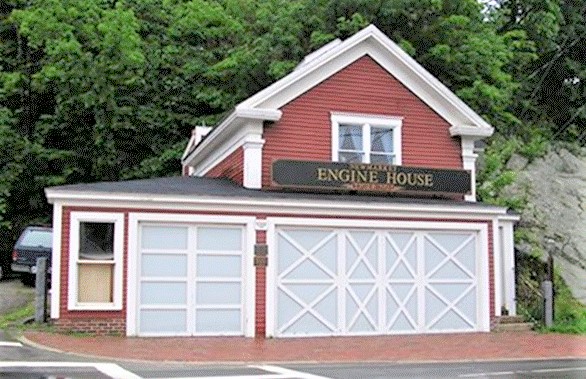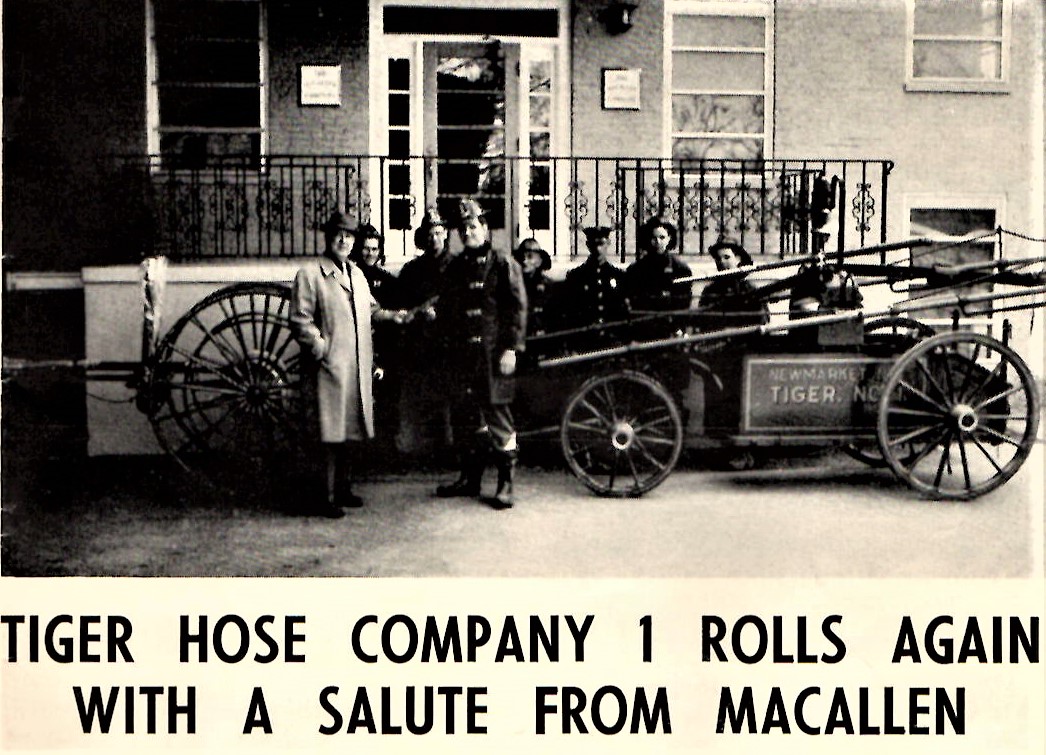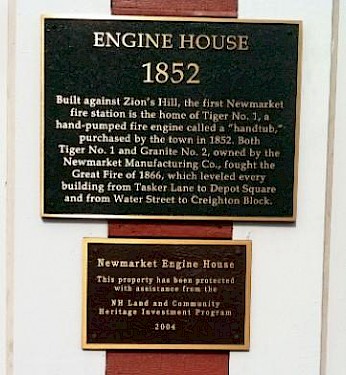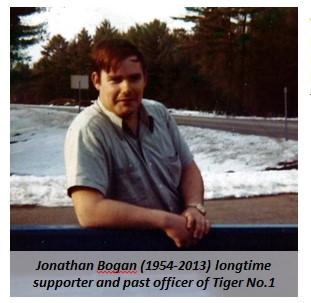

In 1896 Tiger No.1 made its last duty call to the Piecuch farm. It was then retired as an active piece of firefighting apparatus and put into storage where it stayed for over half a century.
There are only two Lesley Hand-tubs still in existence today. Newmarket’s Tiger No. 1 hand tub is the only one in the nation housed in its original firehouse. (NMCo’s Granite No. 2 would meet a different fate, consigned to scrap metal at the onset of World War II.)

 Frank Willey (1883-1965) spent 81 years of his life as a devoted ciizen of the town of Newmarket. He was an active menmber of the of the Newmarket Fire Department for 66 years of his life. In 1954 he discovered the abandonned old Tiger No. 1 and with the help of two friends, George Griswold and Bob Keller, they rebuilt the machine and got it back to working order. Tiger No.1 was then returned to where it had begun service, in the old Engine House on Main Street. The following year the three men enlisted a few more fire volunteers interested in the old hand tub and entered thier first muster in Boston. They ten formed the Newmarket Hand Tub Association, with meetings held upstairs in the old engine house.
Frank Willey (1883-1965) spent 81 years of his life as a devoted ciizen of the town of Newmarket. He was an active menmber of the of the Newmarket Fire Department for 66 years of his life. In 1954 he discovered the abandonned old Tiger No. 1 and with the help of two friends, George Griswold and Bob Keller, they rebuilt the machine and got it back to working order. Tiger No.1 was then returned to where it had begun service, in the old Engine House on Main Street. The following year the three men enlisted a few more fire volunteers interested in the old hand tub and entered thier first muster in Boston. They ten formed the Newmarket Hand Tub Association, with meetings held upstairs in the old engine house.
The original hose reel was found in the basement of MaCallen Building by a Mr. Thayer who realized what this old piece of apparatus was. It was restored by Dick Shanda, Eddie Szacik and the maintence crew of MaCallen and formally turned over to the Newmarket Hand Tub Association on April 27, 1958. It was given to George Griswold, the newly lected president of the Association who added it for use in parades and musters. The reel is also stored in the Old Engine House alsongside Tiger No. 1.
Old and abandoned, the fire station was eventually spruced up by dedicated volunteers. Over 50 years after it was retired from active duty, the old Tiger No. 1 Engine House got a facelift. First, during 2003-04, is when the restoration began. Work on a hose tower was done by the Newmarket Business Association in collaboration with the Old Tiger No. 1 Handtub Association.
The Engine House underwent a more extensive historic renovation process in 2006 through a NH Moose Plate and NH Land Community Heritage Investment Program (L-CHIP) Grant. This project restored the hose drying tower, replaced rotted sills and corrected drainage problems in order to provide a more environmentally safe and secure home for Tiger No. 1.
The building was repainted in 2018 in compliance with the stewardship agreement associated with the NH LCHIP Grant. It is hoped that the building may be opened up for tours and visitation for the general public several times throughout the year.
During the first few years:
1958 & 1959 – Tiger No.1 set records and won more prize money in Fire Muster wins throughout New England. The cash won went into restoration projects for the old Tiger No.1 fire house. 
1960 & 1961 - Champion Class B Hand tub of New England — issued by the New England Veteran Firemen’s Association. In 1960, Newmarket was awarded $325 in prize money. In 1961, the group again won first place for Best in its class for New England hand tubs and was awarded $512 for the year in prize monies from various musters.
In 1970, Tiger No. 1’s hardy operators competed seven times, travelling throughout New England and New York State with their ancient hand tub.
 In August 1974, the Handtub Association dedicated its muster to past and present Newmarket fire chiefs. Three men—Albert Caswell Sr., “Tidoe” Beaulieu, and Robert Keller—represented nearly 25 years’ service and leadership.
In August 1974, the Handtub Association dedicated its muster to past and present Newmarket fire chiefs. Three men—Albert Caswell Sr., “Tidoe” Beaulieu, and Robert Keller—represented nearly 25 years’ service and leadership.
Newmarket’s 250th Celebration
At noon on Saturday August 27, 1977 Newmarket sponsored a New England Hand Tub Muster on the grounds of the high school. Handtubs from New Hampshire, Massachusetts, Rhode Island, Connecticut and New York participated. The hosting handtub—Tiger No.1—was 125 years old.
Muster Setup
 Down the center of the parking lot was a fenced-in area with a strip of paper lying down the center of the area. Along the sides were flags posted along the fence. A distance from this enclosure, a platform or “dock” was erected; close by was a large barrel with a hose leading to a nearby fire hydrant.
Down the center of the parking lot was a fenced-in area with a strip of paper lying down the center of the area. Along the sides were flags posted along the fence. A distance from this enclosure, a platform or “dock” was erected; close by was a large barrel with a hose leading to a nearby fire hydrant.
Handtub members secure their machines on the dock to prevent movement during pumping. Then a 15-minute time limit is given to each tub when a crew can pump as many times and as far as possible.

A foreman sits astride the top of the tub with kerchief over held over his head. The crew relies on this foreman (in 1977 it was Larry Pickering) who watches the flags down the field for the sign of a breeze. The crew on the pumping bars wait as do the men holding and aiming the hose down that strip of paper. The signal comes, muscles tense and the pumping begins – it lasts at the most two or three minutes of an intense workout.
The farthest drop of water is measured and marked. The team may pump again to attain a greater distance until their 15 minutes is up.
 The water barrel oftentimes becomes useful for the dipping and cooling of heads, many a pumper is seen walking around with dripping hair.
The water barrel oftentimes becomes useful for the dipping and cooling of heads, many a pumper is seen walking around with dripping hair.

Trophies are awarded for Class A (big tubs which pump from the sides of the machine) and Class B (smaller tubs which pump from the front and back).
There was a competition in 2019 that Tiger No.1 participated in; however, due to the COVID-19 pandemic, all musters were canceled in 2020. Jack Harclerode plans to reform a group in the near future.
Two mwn who helped keep the Hand Tub Association alive for over 50 years are Jonathan Bogan and Richard Harclerode.

